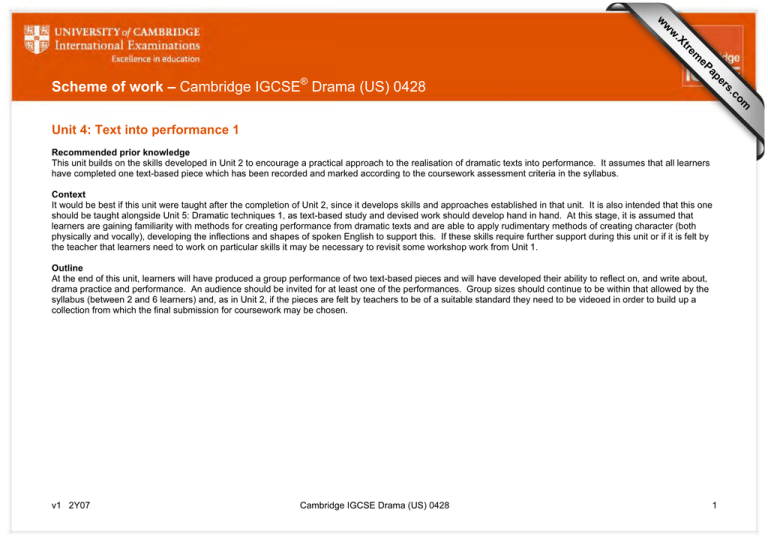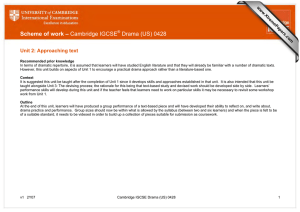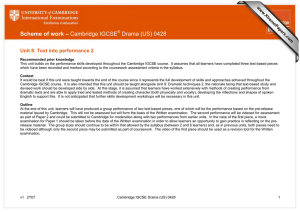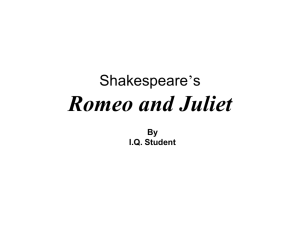Scheme of work – Cambridge IGCSE Drama (US) 0428
advertisement

om .c s er ap eP m e tr .X w w w Scheme of work – Cambridge IGCSE® Drama (US) 0428 Unit 4: Text into performance 1 Recommended prior knowledge This unit builds on the skills developed in Unit 2 to encourage a practical approach to the realisation of dramatic texts into performance. It assumes that all learners have completed one text-based piece which has been recorded and marked according to the coursework assessment criteria in the syllabus. Context It would be best if this unit were taught after the completion of Unit 2, since it develops skills and approaches established in that unit. It is also intended that this one should be taught alongside Unit 5: Dramatic techniques 1, as text-based study and devised work should develop hand in hand. At this stage, it is assumed that learners are gaining familiarity with methods for creating performance from dramatic texts and are able to apply rudimentary methods of creating character (both physically and vocally), developing the inflections and shapes of spoken English to support this. If these skills require further support during this unit or if it is felt by the teacher that learners need to work on particular skills it may be necessary to revisit some workshop work from Unit 1. Outline At the end of this unit, learners will have produced a group performance of two text-based pieces and will have developed their ability to reflect on, and write about, drama practice and performance. An audience should be invited for at least one of the performances. Group sizes should continue to be within that allowed by the syllabus (between 2 and 6 learners) and, as in Unit 2, if the pieces are felt by teachers to be of a suitable standard they need to be videoed in order to build up a collection from which the final submission for coursework may be chosen. v1 2Y07 Cambridge IGCSE Drama (US) 0428 1 Learning objectives Suggested teaching activities Learning resources 1 Review of text-based work in Unit 2 The video of the piece performed in Unit 2 should be reviewed and evaluated by learners. They should start to put themselves and others into mark bands from the Assessment Criteria, with discussion and teacher advice. For an example of how a text may be analysed in terms of performance and technique visit: www.universalteacher.org.uk/drama/viewfromthebridge.htm Since the process of drama is cyclical they should focus on the same aspects of drama identified in Unit 2: • • • • • • making the dialogue meaningful in performance having clarity of diction and articulation understanding the pacing and inflections of spoken English the relationship between spoken word, facial gesture and bodily posture the way in which text is transplanted into performance space the role of the director. Longer texts than in Unit 2 should be chosen, that allow learners to develop further their understanding of: • • • • • • Characterisation and Role Physicality Pacing, Contrast and Dynamics Tension Spatial awareness and Proxemics different sizes/shapes of staging. Basic: (G) Example of a Text into Performance Workshop Romeo and Juliet Warm-ups in pairs, taking turns to summarise things – yesterday, last year, your life so far, your extended family, all in 30 seconds. Reduced Shakespeare Company, The Complete Works of William Shakespeare (Abridged), DVD www.bbc.co.uk/schools/gcsebitesize/english_literature/dra maromeojuliet/ Ask for a volunteer to summarise the plot of Romeo and Juliet. v1 2Y07 Cambridge IGCSE Drama (US) 0428 2 Learning objectives Suggested teaching activities Learning resources Prepare a very brief synopsis of plot and scenes to hand out; discuss. Thumbnail sketches of main characters. Show DVD of Reduced Shakespeare Company version of the play (15 minutes). Zeffirelli’s Romeo and Juliet, DVD Baz Lurhman’s William Shakespeare’s Romeo + Juliet, DVD Take themes from the play: a) Falling in Love. Show couple before they met (Act 1 Sc 1 and 3), and when they met (Act 1 Sc 5). b) The Balcony Scene (Act 2, Sc 2) Show extracts from DVDs by BBC and by Baz Luhrman and the equivalent scene from Shakespeare in Love. Danger he was in entering her garden; role of the Nurse. c) Feuding and Conflict. Compare Shakespeare’s Act 3 Sc 1 with West Side Story Act 1 Sc 9. Use scripts. Shakespeare in Love (1999), DVD 2004, Universal Pictures West Side Story, DVD By this point and this means, learners should be into the play sufficiently to produce performance extracts – but remember that these should be for stage performance, not screen. More challenging aspect: Learners as directors are useful to develop understanding of the holistic approach to moving page to stage. 2 Develop and refine skills in interpreting a piece of dramatic text Work in groups on interpreting two extracts from contrasting dramatic texts. The two in the example above, Romeo and Juliet and West Side Story are different texts on the same theme. More obvious contrasts may be better suited, for example, tragedy/comedy, old people/young people, different races, nationalities and cultures. To enable learners to develop the skills in approaching texts from different periods, one of the two extracts chosen should be from a play written before 1900 and the other should be from a play written after 1900. Learners should practise studying the extracts before commencing work on their realisation. This study should v1 2Y07 Cambridge IGCSE Drama (US) 0428 3 Learning objectives Suggested teaching activities Learning resources enable them to develop skills in the realisation of a text required for Paper 1. Additionally, they should consider the period when the play was written and the extent to which this is reflected in the dialogue. It is helpful to consider historical, social and cultural influences on any play or extract being studied. Was the playwright reflecting the values and views of his/her times? Are they still relevant? 3 Understanding how dramatic texts may be realised and developing skills in writing about them Basic: Learners practise further short-answer questions (such as those found in Section A of Paper 1) and two longer-answer questions on each extract (such as those found in Section B) to allow them an opportunity to reflect on the way they have approached the two texts. The longer-answer questions should focus at this stage on two chosen roles for each learner. As in Unit 2, learners should take an integrated approach to the creation of performance and should consider not just the function of the actors but also that of designers, e.g. costume, set and lighting, sound, as well as the way in which the director might wish to bring out aspects of the play within a given performance space. Learners should reflect on the audience reaction to their performance and the extent to which they achieved the response they intended. Peer assessment, teacher assessment is essential. Use of the mark bands from the Assessment Criteria will assist learning. Often, to video every piece of performance is helpful, not only in case it is selected for coursework submission, but to better facilitate peer and self assessment. More challenging aspect: Encourage learners to make a solo evaluation, justified under peer questioning. v1 2Y07 Cambridge IGCSE Drama (US) 0428 4 v1 2Y07 Cambridge IGCSE Drama (US) 0428 5







